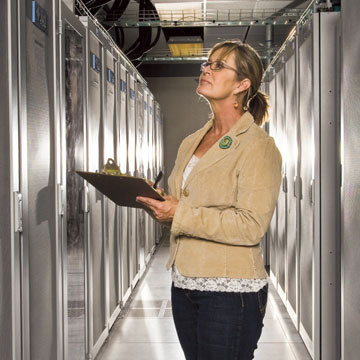Engineers working on Sandia’s newest supercomputer have received some welcome recognition for their hard work: Red Sky made the November 2009 Top500 list as the 10th fastest computer in the world.

Sandia engineers achieved Red Sky’s top-10 performance by temporarily aggregating the Labs’ newest institutional machine with a second system being constructed using the same architecture and components.
SUPERFAST — KATHRYN CHAVEZ (9323) checks the status of systems that make up Sandia’s Red Sky supercomputer. Red Sky has made the Top500.org list as the 10th fastest supercomputer on the planet. Sandia engineers achieved Red Sky’s top-10 performance by temporarily aggregating Sandia’s newest institutional machine with a second system being constructed using the same architecture and components. Story on page 4. (Photo by Randy Montoya)
That second system, sponsored by the DOE’s Office of Energy Efficiency and Renewable Energy, will sit adjacent to Red Sky and be operated by Sandia to support work done at the National Renewable Energy Laboratory.
Red Sky achieved a peak performance of more than 500 teraflops (or 500 trillion mathematical operations per second), and an impressive 433.5 teraflops against the Linpack benchmark commonly used for ranking supercomputing speed.
In addition to raw horsepower, the Labs’ newest supercomputer has been designed to maximize its energy efficiency.
“Red Sky should really be called Green Sky,” says John Zepper (9320), senior manager of Computing Systems & Technology Integration. “This machine is the most energy-efficient high-performance system we have deployed to date.”
The system uses a newly designed power distributing system that significantly reduces power leakage and a unique cooling system that is more than 95 percent efficient in cooling the system’s multitude of computer racks.
“The Red Sky project has leveraged Sandia internal intellectual property and expertise in partnership with Intel and Sun Microsystems to deliver a leading-edge high-performance computing system,” says Rob Leland, director of Computing and Network Services Center 9300.
Red Sky uses a number of innovative technologies, such as interconnect switches designed jointly by Sandia and Sun. These switches were used to build the first implementation of a 3-D torus interconnect topology using InfiniBand networking. The system is also believed to be the first InfiniBand-based system that uses optical interconnect cables exclusively.
For computing, the system uses Sun’s latest high-density dual node computer blades, which come with Intel’s new Nehalem processors.
Red Sky began supporting a limited set of Sandia users this past June and is expected to be in full production this January.